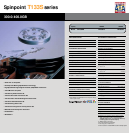
Technology Overview
PMR (Perpendicular Magnetic Recording) and LMR (Longitudinal Magnetic Recording) are recording
methods. As indicated by their names, PMR arranges magnetized cells vertically while LMR does so in
a horizontal fashion. This vertical arrangement allows PMR to record a greater number of data bits in
the same area. The primary reason why density is limited through LMR is a result of what is called
superparamagnetism. Superparamagnetism refers to the phenomenon by which magnetized
materials move closer as the density increases, to the point where they eventually interfere with one
another. As magnetized cells become unstable and as their magnetism changes direction, any stored
data can be rendered unusable. By avoiding superparamagnetism, PMR enables one to further
increase recording density. It is believed that PMR will reach a maximum recording density of 1 TB/in2
(LMR: 200 GB/in2).
Samsung Hard Disk Drive 2007 Product Guide
PMR Technology
Growth of the HDD industry has in the past been explosive, as recording density effectively doubled
each year. But since 2003 this growth rate has radically slowed down, leveling off at about 30-40% a
year. This slowdown has been attributed to difficulties in further increasing the density to meet
continuing demands for ever-higher recording density. As a result, the HDD industry has continued to
devise new technologies capable of allowing for higher recording densities. One such technology is
the recording method known as PMR (Perpendicular Magnetic Recording).
Longitudinal Recording Perpendicular Recording
What is PMR?
“Ring”
Inductive Write Element
Monopole
Inductive Write Element
Read Element
GMR Sensor
Recording
Medium
Soft
Underlayer
Return Pole
Shield 1
Distance
V Write
V Write
Recording
Medium
Magnetizations
Distance
Transition
region
Transition
region
Signal Amplitude
Signal Amplitude
Shield 2
P1
Shield 2
P1
P2 P2


















